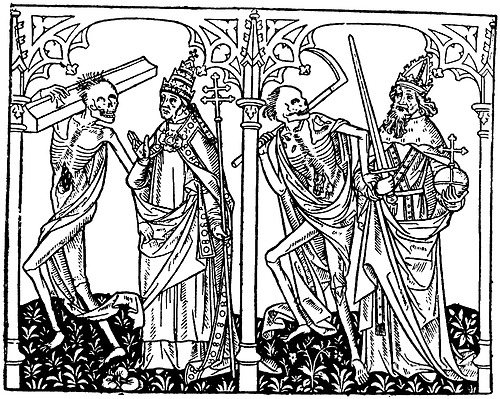A great comment by “Stu Rat” on my previous post led me to take a look at just how deadly Tony Bath’s Hyboria was to NPCs! (see his book “Setting Up a Wargames Campaign”).
Given Tony’s original chart, it seems that you had less than 25% chance of living to see the age of twenty! It got worse the older you got. At 60, you’d basically be advised to just lie in bed till Death came knocking…
|
Age
|
Throw 1d6 –
|
Survival Rate (by tier)
|
|
1-20
|
If 1, throw again: 1-2 dead; 3-4 seriously ill (dies on 1-2 next year); 5-6 minor illness
|
21.45%
|
|
21-40
|
If 1, throw again: 1-3 dead; 4-6 seriously ill
|
17.54%
|
|
41-50
|
If 1-2, throw again: 1-3 dead; 4-6 seriously ill
|
2.61%
|
|
51-60
|
If 1-3, throw again: 1-3 dead; 4-6 seriously ill
|
0.31%
|
|
61+
|
If 1-4, throw again: 1-4 dead; 5-6 seriously ill
|
0.03%
|
So better enjoy those teenage years, as those were the golden days of your life…
Now I don’t know if Tony did the math, if he really used this chart and wondered why all his commanders were dying before battle, but the exercise forced me to think about my campaign, how magick and divine healing may come into the picture and just what is a good life expectancy.
I’ve modeled my campaign against European Middle Ages to some extent, with the Domesday calculations and approach. So it seems reasonable to look at death and life expectancy for that period… except there’s not a lot of agreement except that life was short, brutal and not fun from our modern POV. Here’s an example – flip to page 8: http://content.ucpress.edu/chapters/11633.ch01.pdf
There’s one aspect of life in my campaign that doesn’t factor into the Middle Ages figure though… the presence of magick and divine powers. Unfortunately, I’ve calculated how little that would factor into the survival of a draft pool for a military force, so I am forced to conclude that it wouldn’t factor in very much for a population either. It might/could for specific circumstances – those who can afford it, or for our brave PCs, but by and large, not so much.
So, what to do? I’m going to go back to the original calculations I made and assume that for children and most adults, a 50% life expectancy for most of their life is reasonable. From poking around the web, that number for the Middle Ages has cropped up, and it feels right for me. My campaign is about imagination and “Yea, I like this, we’ll go with this” versus a simulationist approach. So here’s the updated chart:
|
Age
|
Throw 1d6 –
|
Survival Rate by tier
|
|
1-20
|
If 1, throw again: 1 dead; 2 seriously ill (dies on 1-2 next year, 3 seriously ill)
|
47%
|
|
21-40
|
If 1, throw again: 1 dead; 2-3 seriously ill
|
57%
|
|
41-50
|
If 1, throw again: 1-2 dead; 3-4 seriously ill
|
56%
|
|
51-60
|
If 1-2, throw again: 1-2 dead; 3-5 seriously ill
|
31%
|
|
61-70
|
If 1-2, throw again: 1-3 dead; 4-6 seriously ill
|
16%
|
|
70+
|
If 1-3, throw again: 1-3 dead; 4-6 seriously ill
|
6%
|
This feels right to me, and maintains the approach that Tony originally took. I wonder what he would have thought about this approach.

I think your table is black text on a black background? Except for the 31, 16, and 6% cells.
Thanks @Alan, fixed!
I like that table! This is stuff that I had never thought of, and it is an interesting one on multiple levels, but what really pleases me is the PDF that you linked to. I haven't read it yet, but by skimming through it, it is apparent that it is gold! This appears to be a fair look at history, I personally despise historical views which have people moping around because they don't have Pepsi Cola. I work in the mental health industry and have seen people who live in hellish conditions and I know that the human spirit is made of iron. Our view of the past is cloudy, and in order to understand we have to shed our baggage, thus, articles like this one are incredibly fun for me to ponder.
While this is a morbid subject, to apply it to our games is not as easy as one would think. In 2e there is a table which you can roll against which will tell you a PC's life expectancy, just in case he doesn't die from misadventure. Age is handled on a technical level, and while it is probably, for the most part, ignored, it does offer some insight as to what the designers were thinking. I wonder just how accurate it is?
@RipperX – good point. Life does find a way.
I'm not good enough at the math to convert the life expectancy (usually measured in years) to a graph that could be duplicated by dice rolls. I don't think it would be a bell curve (survival rate), but I could be wrong. In my campaign, I would say that the medical science has slid back to roughly the Middle Ages. If I ever find a historically accurate graph that shows life expectancy rates as a percentage partitioned by years, I'll definitely use it.
Sometimes, though, I just have to say "this feels right for my game" and use it.
Nice post. Interesting that most deaths (I ran through the numbers) occur at an age of 2 or 3 which does not seem unreasonable, as kids being weak and vulnerable. Don't you love it when emergent effects actually make sense.
You might want to consider different mortality rates for different life standards